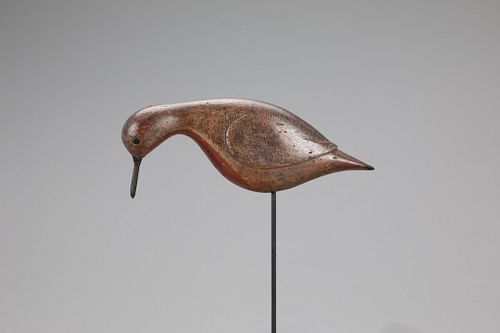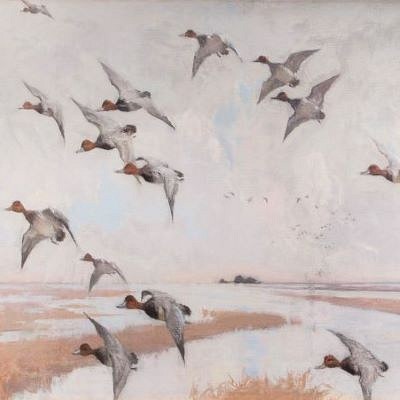Exceedingly Rare Feeding Robin Snipe Decoy, Obediah Verity (1813-1901)
About Seller
20 Winter Street
Pembroke, MA 02359
United States
Founded in 2005, Copley Fine Art Auctions is a boutique auction house specializing in antique decoys and American, sporting, and wildlife paintings. Over the course of the last two decades, the firm has set auction records for not only individual decoy makers, but also entire carving regions. Copley...Read more
Two ways to bid:
- Leave a max absentee bid and the platform will bid on your behalf up to your maximum bid during the live auction.
- Bid live during the auction and your bids will be submitted real-time to the auctioneer.
Bid Increments
| Price | Bid Increment |
|---|---|
| $0 | $50 |
| $1,000 | $100 |
| $2,500 | $250 |
| $5,000 | $500 |
| $10,000 | $1,000 |
| $25,000 | $2,500 |
| $50,000 | $5,000 |
About Auction
Feb 19, 2021
Lots 1-292 Copley Fine Art Auctions cinnie@copleyart.com
- Lot Description
Obediah Verity (1813-1901)
Seaford, Long Island, NY, c. 1880
10 1/4 in. long
A shorebird with one of the world's longest migrations, the robin snipe, or red knot as it is commonly known, has long been sought after by decoy collectors. Decoy historian Henry Fleckenstein states "...few robin snipe or knot decoys that were made by Verity have been collected." Fellow author Jeff Waingrow, discussing Long Island shorebird decoys, states, "Much of the local production was of yellowlegs and plover, though sanderlings, curlews, terns, knots, and turnstones are all known. Most were carved in a conventional pose, so those few yellowlegs and plover in feeding postures are sought with special avidity..." He continues, "Almost any shorebird from the area is highly collectible, for as most advanced collectors will agree there was a consistently high standard set in that small town that knows no equal in the entire world of decoys." The Verity name is literally synonymous with the sporting mecca of Seaford having at one time been called Verity Town. The virtual absence of a feeding robin snipe among the known plover and yellowlegs feeders found in publications has been the subject of notable attention. One celebrated comparable can be found in the pages of William J. Mackey and Quintina Colio's books.
Aside from rarity, the form of this red knot places it among Verity's finest patterns. The elegant clean design displays a deep feeding pose that perfectly captures the probing nature of the species. Verity aficionados will recognize that the Verity wing carving is worthy of special attention. The carver's raised wing treatment is broadly known to have an S-curve at the front of the wing and a sharp V-form at the wing-tip resolution. This inspired example flips these elements with a sharp V-cut in the front and perfectly executed arcs at the wing tips.
Like carving masters A. Elmer Crowell and Fred Nichols of Massachusetts, this Long Island maker appears to be executing astute adjustments for the special deep feeding posture. The placement of the sharp V-incision on the side of the bird serves as a perfect contrast to the round and sweeping lines that otherwise dominate the pattern. This rare, and perhaps unique, example is among the finest decoys to survive the intense hunting conditions of the famous sporting destination. The surface is finished with the artist's tight stippled paint and a light scattering of shot, a signature of the area. This Seaford jewel is among the finest red knot decoys from any region.
Original paint with even gunning wear, some gunning touch-up to feathering and breast, replaced bill.
Provenance: Dr. Peter J. Muller Jr. Collection, acquired at William Doyle Galleries, November 1981
Literature: Robert Shaw, "Bird Decoys of North America," New York, NY, 2010, p. 180, related examples illustrated including upright robin snipe and feeding plover. Jeff Waingrow, "American Wildfowl Decoys," New York, NY, 1989, p. 42, feeding yellowlegs illustrated. Henry A. Fleckenstein Jr., "Shore Bird Decoys," Exton, PA, 1980, p. 25, upright knot illustrated. William J. Mackey Jr., "American Bird Decoys," New York, NY, 1965, p. 102, Mackey feeding knot illustrated. Quintina Colio, "American Decoys," Ephrata, PA, 1972, p. 73, Mackey feeding knot illustrated.Please email condition report requests to colin@copleyart.com. Any condition statement given is a courtesy to customers, Copley will not be held responsible for any errors or omissions. The absence of a condition statement does not imply that the lot is in perfect condition.Condition
- Shipping Info
-
Copley Fine Art Auctions does not handle the shipping of any items. Shipping is the sole responsibility of the buyer. Once your payment has cleared and we have received your shipping form, items may be released for shipment. Copley Fine Art Auctions, LLC shall have no liability for any loss or damage to such items. Buyers should allow up to four weeks for shipment.
Please be aware that internet bidders may NOT not pick up their items at the sale. Items will be available for pick up by appointment or by shippers five days after the sale.
-
- Buyer's Premium



 EUR
EUR CAD
CAD AUD
AUD GBP
GBP MXN
MXN HKD
HKD CNY
CNY MYR
MYR SEK
SEK SGD
SGD CHF
CHF THB
THB















